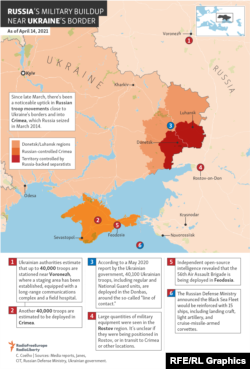Russia says it has started moving troops from the annexed Ukrainian region of Crimea to their permanent bases following a major buildup around the areas of eastern Ukraine that had raised concerns in Kyiv and the West.
A senior U.S. defense official said on April 23 that the United States is seeing some Russian personnel withdrawing, but added: "It's a bit too soon to tell exactly what forces are withdrawing and exactly what equipment appears to be left behind.”
Moscow's announcement of the troop redeployment alone is "insufficient to give us comfort," the official told Reuters, speaking on condition of anonymity.
“But I can just tell you, we're looking very, very closely," the official said.
The Russian troop buildup came amid stepped-up violations of a cease-fire in eastern Ukraine, where fighting between Ukrainian government forces and Russia-backed separatists has killed more than 13,000 people since April 2014, and prompted the West to urge Moscow to pull its forces back.
Ukraine and many other countries refuse to recognize Russia’s annexation of Crimea in March 2014, and consider it a violation of international law and Russian-signed agreements safeguarding the territorial integrity of Ukraine.
The Russian Defense Ministry said on April 23 that "military units and groups [in Crimea] are moving to railway stations and airports, boarding military vessels, railway platforms, and military aircraft” following the conclusion of large-scale military drills.
The ministry also announced that more than 20 ships from its Black Sea fleet had returned to their permanent base after taking part in military exercises near Crimea.
The statements came a day after Russian Defense Minister Sergei Shoigu ordered the withdrawal from areas close to the Ukrainian border, where thousands of military personnel had been brought in recent weeks for what Moscow described as a "snap inspection of military personnel."
Shoigu said that the objectives of the snap inspection "have been fully achieved" and that the troops would return to their bases by May 1.
However, it was unclear from Shoigu's announcement if the return order covered all of the troops involved in the buildup near Russia's southern border and in Crimea.
The Defense Ministry has said that its drills involved more than 60 ships, over 10,000 troops, around 200 aircraft, and about 1,200 military vehicles.
But the military hasn't reported the total number of additional troops that have been moved to the region.
Josep Borrell, the EU's top diplomat, said on April 19 that Russia had massed some 100,000 troops near the border, while Ukrainian Foreign Minister Dmytro Kuleba warned on April 20 that the Russian buildup across the border was continuing and was "expected to reach a combined force of over 120,000 troops" in about a week if it didn't stop.
Russia has argued that it has the right to deploy its forces anywhere on its territory and claimed that they don't threaten anyone.
Shoigu said the military had to be ready to respond quickly in case of "unfavorable" developments arising from NATO's DEFENDER-Europe 21 exercises, an annual, U.S. Army-led, multinational joint exercise across 26 countries in Europe and Africa, including Estonia -- which shares a border with Russia -- Bulgaria and Romania.
Last week, Russia announced the closing of large areas of the Black Sea near Crimea to foreign naval ships and state vessels until November, prompting protests from Ukraine and raising Western concerns.
Moscow also announced restrictions on flights near Crimea this week, arguing that they fully conform with international law.
Moscow also warned Kyiv against trying to retake by force its territories controlled by the separatists, saying that Russia could step in to protect civilians in the region.
Ukrainian President Volodymyr Zelenskiy on April 21 signed an order allowing the call-up of reservists for military service without announcing a mobilization.











